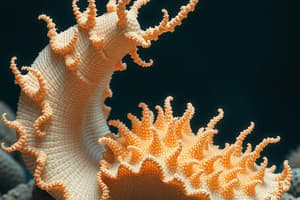Podcast
Questions and Answers
What are the identifying characteristics of mollusks? (Select all that apply)
What are the identifying characteristics of mollusks? (Select all that apply)
- Most have internal or external shell (correct)
- Unsegmented soft body (correct)
- Have a radula (correct)
- Have a backbone
How is a pearl formed?
How is a pearl formed?
A pearl is formed inside of an oyster from sand, water, and other debris.
Can you name examples of animals under Phylum Mollusca?
Can you name examples of animals under Phylum Mollusca?
Clams, Chitons, Squids, Cuttlefish, Octopus, Snails
Why is a Nautilus unique among the cephalopods?
Why is a Nautilus unique among the cephalopods?
How does a clam move and what structure does it use?
How does a clam move and what structure does it use?
How is jet propulsion used in cephalopod locomotion?
How is jet propulsion used in cephalopod locomotion?
What is a pneumostome and what is its function?
What is a pneumostome and what is its function?
What are the diverse respiratory functions in mollusks?
What are the diverse respiratory functions in mollusks?
What is the primary function of the mantle?
What is the primary function of the mantle?
Describe the circulatory systems in mollusks.
Describe the circulatory systems in mollusks.
How does a pearl form in a bivalve?
How does a pearl form in a bivalve?
What is the function of the radula in cephalopods?
What is the function of the radula in cephalopods?
Name examples of Class Cephalopoda.
Name examples of Class Cephalopoda.
Name examples of Class Gastropoda.
Name examples of Class Gastropoda.
Name examples of Class Bivalvia.
Name examples of Class Bivalvia.
What are the identifying characteristics of Class Cephalopoda? (Select all that apply)
What are the identifying characteristics of Class Cephalopoda? (Select all that apply)
What are the identifying characteristics of Class Bivalvia? (Select all that apply)
What are the identifying characteristics of Class Bivalvia? (Select all that apply)
What are the identifying characteristics of Class Gastropoda? (Select all that apply)
What are the identifying characteristics of Class Gastropoda? (Select all that apply)
Flashcards are hidden until you start studying
Study Notes
Identifying Characteristics of Mollusks
- Unsegmented soft body, typically featuring internal or external shells.
- Presence of a mantle, a fold in the body wall that secretes protective shells.
- Muscular foot and/or tentacles are characteristic features.
- Radula: a toothed structure used to grate and obtain food.
Formation of Pearls
- Pearls form inside oysters when sand, water, and debris causes irritation.
- The mollusk secretes nacre (mother of pearl) layers around the irritant, which builds up over time.
Animal Examples in Phylum Mollusca
- Includes clams, chitons, squids, cuttlefish, octopuses, and snails.
Unique Features of Nautilus
- Nautilus has numerous slender tentacles and an external coiled pearly shell.
- Its shell is divided into air-filled chambers, differentiating it from other cephalopods.
Clam Movement
- Clams move using a muscular organ called the foot, located between the two shells.
- The foot extends to aid locomotion and is protected by the clam’s shell.
Jet Propulsion in Cephalopods
- Octopuses and squids utilize jet propulsion for movement.
- They fill the muscular mantle cavity with water and expel it through a siphon, propelling themselves in the opposite direction.
Pneumostome in Snails
- Pneumostome: an opening in the mantle of snails/slugs allowing air entry.
- Functions as an entrance to a single lung located in the mantle cavity, which is highly vascularized.
Respiratory Functions in Mollusks
- Respiratory and circulatory systems lie in the visceral mass.
- Aquatic species, like snails or clams, breathe using gills located in the mantle cavity.
Function of the Mantle
- Primary role is to enclose and protect internal organs.
- Provides space for the mantle cavity, which facilitates respiration and holds air or water.
Circulatory Systems in Mollusks
- Mollusks can exhibit open or closed circulatory systems.
- Open systems allow blood to move freely between cells and internal tissues.
- Closed systems restrict blood flow strictly within vessels, enhancing efficiency.
Pearl Formation in Bivalves
- Irritation from an intruder leads bivalves to form a pearl sac from mantle tissue.
- Calcium carbonate and conchiolin are secreted around the irritant, forming a pearl over time.
Radula in Cephalopods
- Radula: a feeding structure compared to a tongue with tiny teeth.
- Used for scraping or cutting food before ingestion through the esophagus.
Examples of Class Cephalopoda
- Notable members include octopus, squid, nautilus, cuttlefish, and vampire squid.
Examples of Class Gastropoda
- Includes slugs, snails, sea hares, slipper shells, and sea butterflies.
Examples of Class Bivalvia
- Features mussels, oysters, scallops, and clams.
Identifying Characteristics of Class Cephalopoda
- Features tentacles (8-10 limbs), pigment cells, and an ink sac.
- Internal or absent shells, with sophisticated organ systems and eyes similar to human eyes.
Identifying Characteristics of Class Bivalvia
- Lack distinct heads or eyes; possess soft bodies and two shells joined by a hinge.
- Primarily filter feeders.
Identifying Characteristics of Class Gastropoda
- Use a muscular foot for movement and typically have a single retractable shell.
- Undergo torsion during larval development, affecting body structure; equipped with a radula.
Studying That Suits You
Use AI to generate personalized quizzes and flashcards to suit your learning preferences.




